-
Posts
2,123 -
Joined
-
Last visited
-
Days Won
3
Content Type
Profiles
Forums
Blogs
Gallery
Events
Store
Posts posted by Paul L Murphy
-
-
I think the form of insert has changed over the years since the most recent examples of this medal have a different explanatory leaflet with them. I do not have one to hand at the moment. I have also seen examples where there was no leaflet. All of these are post war.
0 -
I think the name is Futaka, it is hard to make out. Apart from this type, the 1st class badges have green enamel as part of the design. This is the only 1st class badge which does not. It is also one of the rarer badges, all the 1st class pieces are very hard to find. I will post some photos of other 1st class badges over the coming days.
0 -
Case
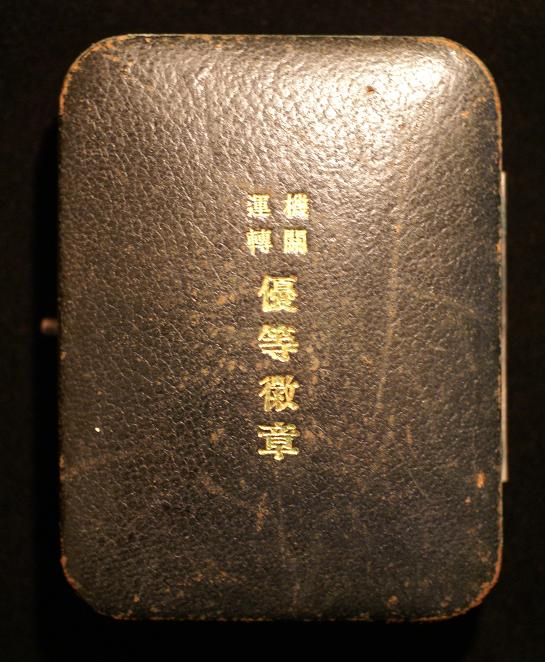 0
0 -
The reverse has a name unofficially scratched onto it.
 0
0 -
reverse
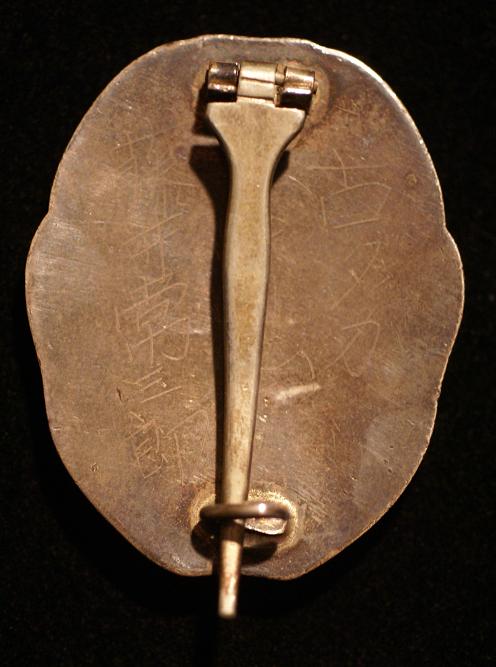 0
0 -
This badge is described in Peterson but it is so rare that they only had a line drawing to illustrate it, no photo. So here is a photo of the obverse and reverse, together with a photo of the case. It is the 1st Class Engine Operation Proficiency Badge of the Imperial Japanese Navy. A very attractive and rare item and you saw it here first folks. It measures 45 x 37mm and weighs 26.5 grams. It is made from silver and copper is constructed from at least four parts since the central chrysanthemum, anchor, engine prop, and background are all seperate pieces braised and rivetted together. The quality of manufacture is very good, far better than the army badges from the same period.

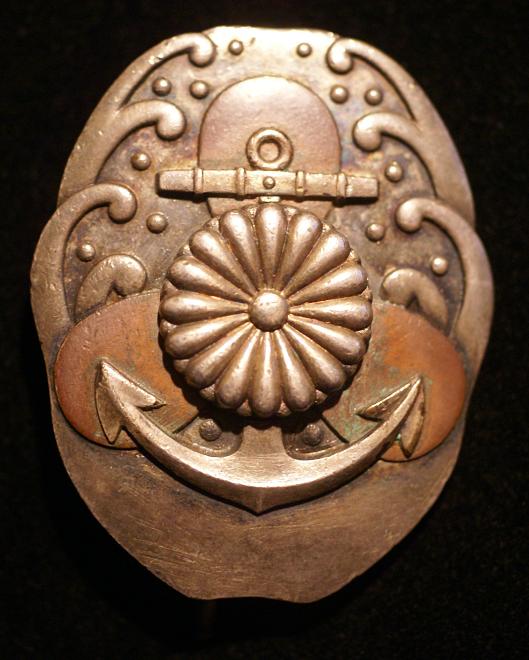 0
0 -
The one on the left looks like a sergeant, given the horizontal braid bars on the shoulder boards.
0 -
Unfortunately this is not an original bar. You have already noticed that the ribbons show no age wear at all. Not only that, they are in the incorrect order on the bar. Furthermore, the last ribbon appears to the be French Croix de Guerre TOE with a silver star citation rather than a German ribbon.
There are a number of very knowledgeable German collectors here and some very informative posts on identifying good versus bad ribbon bars so I suggest you defer your purchases until you have had a chance to read through these and thereby avoid expensive mistakes.
0 -
The documents are not scarce but they are often overlooked since they are smaller than government certificates. I suspect most of them ended up in the rubbish.
0 -
My biggest selling regret was a group of over 40 documents and certificates to a Warrant Officer in the Kempeitai. I made a very nice profit on them but I should have kept them (I was young and foolish). He had served from 1894 until the 1930s, it was a beautiful group. Sigh........
 :banger:0
:banger:0 -
Also to point out that the medal shown is the Turkish War Medal for the Crimea, not the British medal. If his Turkish medal survived then there is a good chance that the British medal is out there somewhere as well. Reuniting them would be quite a challange though.
0 -
Paul,
Very beautiful documents. I would be very proud to have them in my war room. Well done.
On a side note, would it be very hard to get the current emperor's signature?
The current emperor's signature is the only one I am still missing. He still signs 1st and 2nd class certificates so it is a matter of waiting until one comes on the market. Most likely early 1990s certificates to foreign recipients will start to come on the market soon (deceased former ambassadors to Japan etc) so I am waiting patiently.
0 -
I'm afraid the document and medal do not go together. The document is for a "Full Member" which is the term used for a normal member of the society, whereas the medal is for a Special Member.
0 -
Some more details on the construction etc.
The ribbons are as follows :
1st Row : Order of the Bath; Order of the British Empire (Civil)
2nd Row : DSO; MC and bar; 1914-18 War Medal
3rd Row : Victory Medal with MiD; Territorial Force War Medal; 1908-36 Indian General Service Medal
4th Row : 1918-62 General Service Medal with MiD; 1939-45 Star, Africa Star with 8th Army bar;
5th Row : Italy Star; France & Germany Star; Defense Medal; War Medal;
6th Row : Africa Service Medal; Territorial Efficiency Medal or Territorial Decoration (same ribbon); French Medaille Militaire; French WWII Croix de Guerre
The ribbons are all original silk type material and all seem to be made over a cardboard core. The ribbons, thread etc. do not glow under a black light so if this was made up (which is always possible) then it was done a long time ago. The source for both this and the other ribbon group was an ebay seller who did not normally sell military items, listed them at £1 each (or thereabouts), and claimed that they came from a military tailor who had the job of disposing of old uniforms and who kept the badges and ribbons that he removed from these. A plausible stoty, but then again stories are easily made up and difficult to verify. For what I paid for this it was worth a punt on it being original since the component parts definitely are.
If it is original then what clues have we got so far ? His highest award could be a Companion of the Bath so this would open it up to Colonels etc. He has a post 1937 civil CBE ? He joined the territorial army before 1910 (4 years service before the outbreak of WWI was a requirement for the Territorial Force War Medal). He served in Kenya since this is the only post WWII bar to the AGS. He was awarded the French Medaille Militaire in WWI, which means he was an enlisted man for at least part of his active service between 1916-18. He was decorated for bravery three times after he became an officer (DSO and two MCs). While this is not impossible, it is implausible.
Mervyn's comment on the uniform cloth is very valid, and not something I had paid much attention to up to now. The cloth is consistent with WWII other ranks battledress uniform cloth, not officer's cloth. I have re-examined it from the reverse. It does not show up well in the photo but the fourth and fifth rows of ribbons are stiched with a much better quality of stich than the other rows. The top three rows have a large "tacking stitch" for want of a better expression. This continues onto the other rows but beneath it you can see a finer stich in rows four and five. The last row is stitched on with a different colour thread (white rather than cream). This leads me to conclude that the original ribbons for this are the GSM with MiD and the WWII medals, ie. rows four and five only. I suspect the rest were added later, even though they are all genuine parts. I will probably break it into its constituent parts and leave the original two rows on the cloth, unless someone out there still thinks that it is an original grouping.
:cheers:
0 -
Mervyn,
Yes it did. I have commented more fully on them in the other thread.
Regards,
Paul
0 -
They do not have to remain together. I have seen a number of photos where WWI medal ribbons are split across two rows.
I agree the alignment on the ribbons is not great but some of the ribbons are different widths (eg DSO is narrower than the Victory Medal with MiD) and the left hand part of the cloth would have been under the tunic collar. I had put it down to these two factors.
0 -
This is another ribbon bar I purchased some time ago expecting it would be easy to pin down the wearer. So far I have not been able to do so, so any help is gratefully received. I thought the French Medaille Militaire would be the key since it is only awarded to other ranks or generals. Given the presence of the Order of the Bath, DSO, MC and bar etc I presumed this was for a WWII general who got the Medaille Militaire. Unfortunately the only British general to get it for WWII was Montgomery, and this combination of ribbons is not consistent with his awards (eg no 1914 Star etc). Hence, the Medaille Militaire must have been a WWI award as an other rank.
Soooo.... we have a ribbon group to a territorial other rank who fought in WWI and was possibly promoted to officer during that conflict. The Order of the British Empire is a civil ribbon which is curious. Leaving this aside, he must have reached a reasonably high rank to get at least a CB. Anyone got any ideas who it could be ?
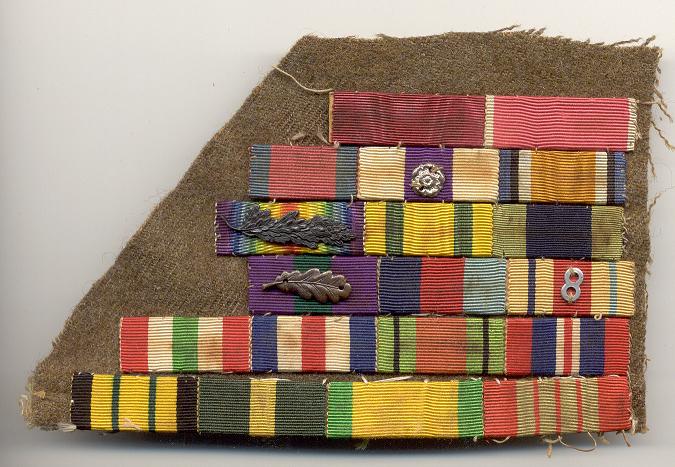
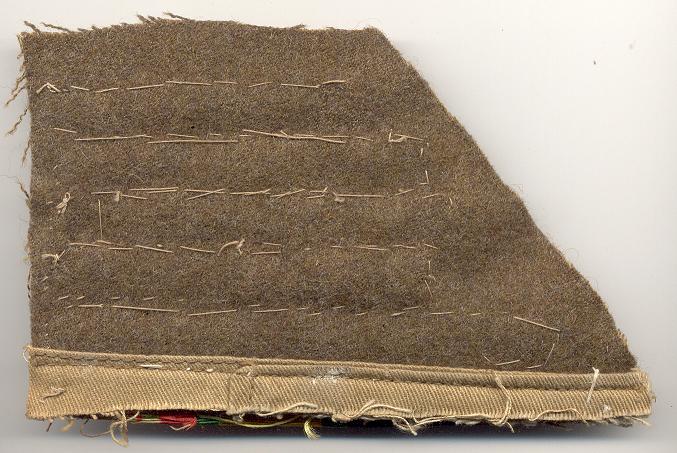 0
0 -
Well folks, I finally managed to dig this ribbon group out of the bank vault and take some more photos. Unfortunately I am no closer to identifying the recipient. Now that you can get a good look at it, all suggestions gratefully received.

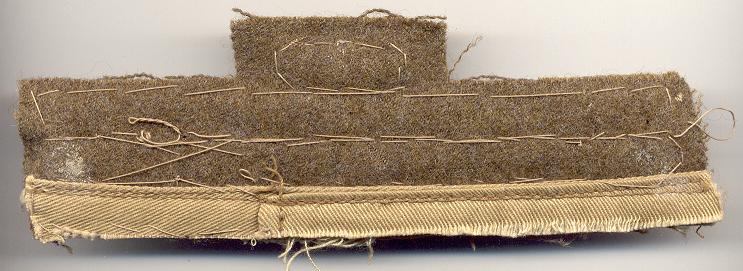 0
0 -
This is one of my latest purchases. The GSM with Palestine bar is named to 2752069 Cpl E Mathew Black Watch. The WWII medals are unnamed as issued, and the LS&GC has the same details except his unit is now CRMP (Corps of Royal Military Police). Came with no research but given the combination of medals I am pretty sure he was in the 2nd Battalion of the Black Watch since they were stationed in Palestine at the outbreak of WWII. They then went to Italian Somaliland, after which they ended up as part of the garrison on Crete. When they were evacuated from Crete then ended up in North Africa and were in the garrison at Tobruk during that famous siege. They then were sent to the Far East and were one of the units in the 2nd Chindit Expedition.
If anyone can recommend any good books that focus on the activities of the Black Watch in WWII I would appreciate the names. These were certainly a very well deserved group of medals.
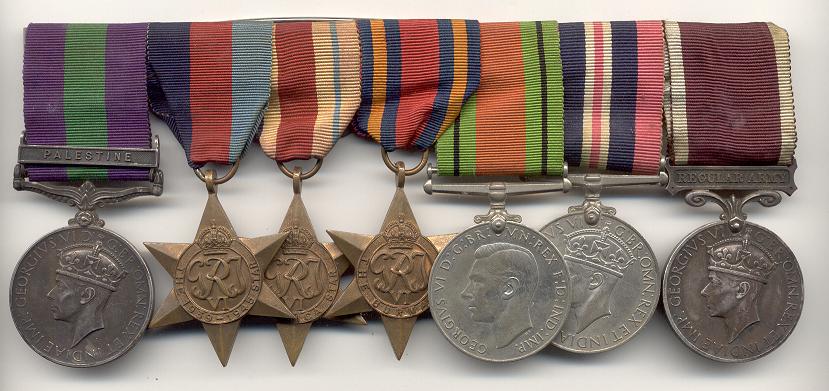 0
0 -
Further proof that you should stick with reliable sellers like myself

:cheers:
0 -
I would say your most likely pair of medals were a Colonial Medal and a Maroc Medal (1909). However it could be anything from the Madagascar medals, Tonkin medal, Dahomey medal, China Medal (1900-01) or indeed a Medaille Militaire.
0 -
Would it not sell in Japan because they prefer only pristine items? Personally, I like items that were worn and/or used by the soldier, sailor or airman. It's a matter of taste, but an medal or insignia that is was unissued and sat on a shelf is less interesting to me than one that has that "was-there" look about it. On the other hand, I'll be the first to admit that I always look at condtion and rarity in conjunction to the history. In short, do you think there are "cultural" differences in collecting militaria? In general, do the Japanese only want perfect single medals that are cased? Have never been fortunate enough to visit Japan, it would be interesting to know what you think. Cheers and happy New Year to everyone!

Correct. The Japanese like items in excellent condition. They do not have to be pristine, however they do need to have complete original ribbons and no enamel damage. Also I have seen boxed examples regualrly go for more than doubel the price of the unboxed medal, effectively giving the case the same inherent value as the medal itself !
0 -
I would describe it as "Very Fine with ribbon damage and toning". Japanese items are one of the countries where you want to avoid changing ribbons (unlike British medals where that is less of an issue). A piece in this condition would never sell in Japan unless it was for about 25% of the normal market price.
0 -
It looks ok. The reverse is correct for the period after about 1959 so it would be one of the later batches of badges made for the unit.
0




Golden Kite Question
in Japan
Posted
Unfortunately I do not have a 4th class document but it would show a rosette if one existed. It would be normal to add the rosette after the regulations changed. Let me look back over any photos I have here to see if I can find any evidence either way.